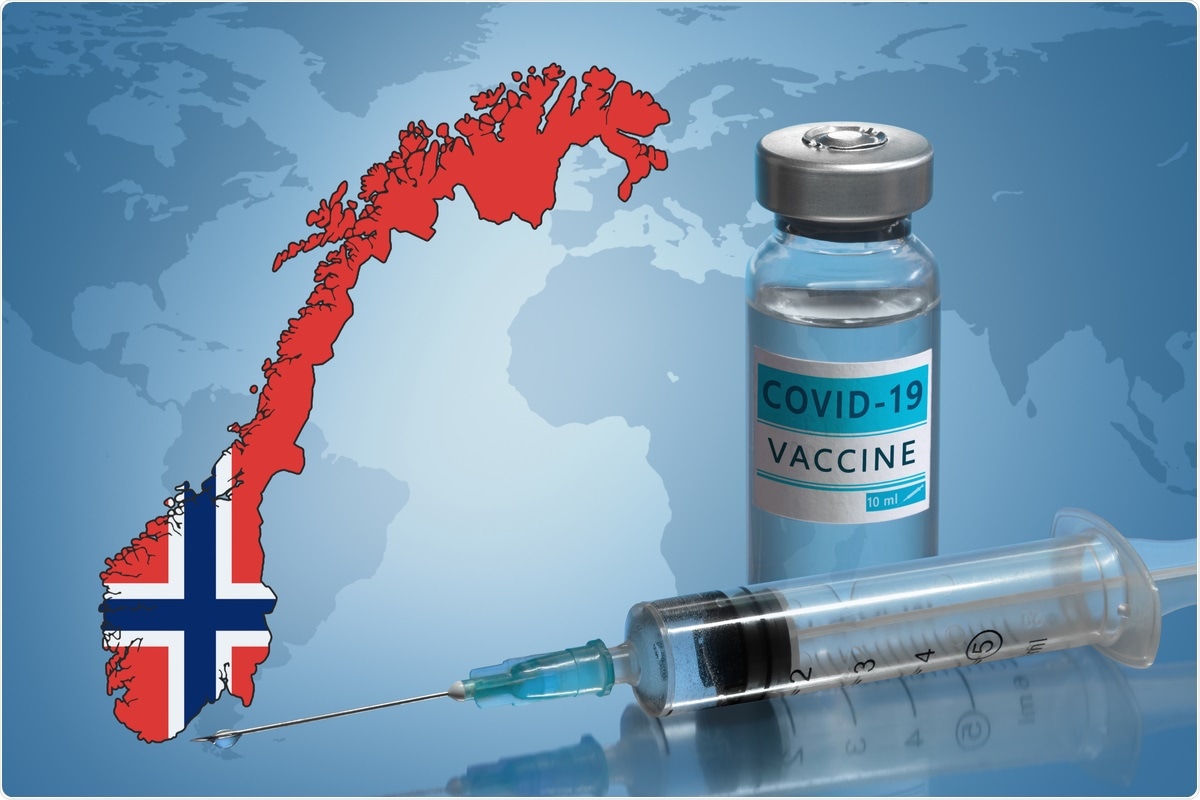In late 2019 in Wuhan city, China, a novel betacoronavirus was found to be responsible for acute respiratory syndrome cases and was later termed severe acute respiratory syndrome coronavirus 2 (SARS-CoV-2). SARS-CoV-2 is the causative agent of coronavirus 2019 (COVID-19), which rapidly spread since it was first reported and was declared a pandemic by the World Health Organization (WHO) on 11th of March 2020.
 Study: Age and product dependent vaccine effectiveness against SARS-CoV-2 infection and hospitalisation among adults in Norway: a national cohort study, January – September 2021. Image Credit: YAKOBCHUK V/ Shutterstock
Study: Age and product dependent vaccine effectiveness against SARS-CoV-2 infection and hospitalisation among adults in Norway: a national cohort study, January – September 2021. Image Credit: YAKOBCHUK V/ Shutterstock
World healthcare systems were put under immense pressure with rising cases, leading to many countries imposing restrictions, such as mask-wearing and social distancing. However, these restrictions were only a temporary solution, and the need for pharmaceutical interventions, such as vaccines, was required.
The SARS-CoV-2 vaccines have been shown to exhibit high levels of protection against COVID-19, and the vaccine effectiveness (VE) increases with the severity of the outcome. VE against infection is lower than hospitalization, intensive care unit (ICU) admission, and death. Recent research has suggested that the SARS-CoV-2 vaccines offer 83% effectiveness collectively, with higher protection associated with the mRNA-based vaccines. However, VE may differ with virus variants, dose intervals, and population structure.
A team of researchers from various Norwegian institutions in this study quantified the general VE achieved in the population of Norway, with the realized mixture of vaccine types, current population characteristics, and epidemic trajectory and directly estimated VE across vaccine types and age groups. To evaluate the impact of SARS-CoV-2 vaccination in Norway, the authors estimated the VE against COVID-19, COVID-19-related hospitalization, specifically looking at differences between age and vaccine regimen.
A preprint version of this study, which is yet to undergo peer review, is available on the medRxiv* server
The study
In this study, there were 4,293,544 individuals included, of which 3,843,420 had received at least one dose of vaccine during the study period. Out of all the participants, 88,618 had been diagnosed with COVID-19, 2,752 were hospitalized due to COVID-19-related issues, 530 needed ICU admission, and 323 died due to COVID-19.
The overall VE in fully vaccinated individuals is 72.1% against infection and 92.9% against COVID-19 related hospitalization, adjusted for age, sex, pre-existing morbidities, location, nationality, and crowded living conditions. VE against infection in fully vaccinated was highest with a heterologous mRNA regimen (84.7%), followed by Spikevax (78.3%) and Comirnaty (69.7%), Vaxzevria with mRNA (60.7%), and two doses of Vaxzevria (43.4%). The authors could only estimate VE against hospitalization for Comirnaty and Spikevax, of which both displayed high effectiveness: 81.0% – 84.7% for partially vaccinated and 91.6% – 96.7% for fully vaccinated. Estimations of VE against hospitalization for the other vaccines were not possible because there were no hospitalizations in those who received the heterologous mRNA vaccine and too few with Vaxzevria during the study period.
There was a higher VE displayed in Spikevax against infection when compared to Comirnaty in those <65 years, those ≥65 years the confidence intervals overlapped. In the age groups in which VE could be estimated, the overall effectiveness of heterologous mRNA vaccine regimens was as high or higher than either mRNA vaccine separately. Within most of the age groups within this study, Vaxzevria administered in combination with mRNA vaccine was less effective against infection with SARS-CoV-2 when compared to other vaccine regimens.
Implications
The data collected in this study shows high VE against COVID-19 associated hospitalization, ICU admissions, and death among those who are partially and fully vaccinated, in all the age groups, and with all vaccine types. However, VE was lower among the partially vaccinated, and VE appeared to decrease in fully vaccinated individuals as age increased. Additionally, the highest protection was elicited in those who received a homologous Spikevax and heterologous mRNA regimen for the younger age groups.
To successfully combat COVID-19, appropriate prioritization and well-planned vaccine campaigns are essential, and this is only viable with updated knowledge on VE of realistic vaccination regimens achieved in large populations. The results collected from the adult Norwegians show high protection against severe complications associated with COVID-19 following the first dose of the vaccine. In all the regimens examined where at least one of the doses is an mRNA-based vaccination, protection against a SARS-CoV-2 infection appeared to be good. Overall, the results from this study support the use of heterologous schedules, increasing flexibility in vaccination policy.
*Important notice
medRxiv publishes preliminary scientific reports that are not peer-reviewed and, therefore, should not be regarded as conclusive, guide clinical practice/health-related behavior, or treated as established information.
-
Starrfelt, J. et al. (2021) "Age and product dependent vaccine effectiveness against SARS-CoV-2 infection and hospitalisation among adults in Norway: a national cohort study, January – September 2021". medRxiv. doi: 10.1101/2021.11.12.21266222 https://www.medrxiv.org/content/10.1101/2021.11.12.21266222v1
Posted in: Medical Science News | Medical Research News | Disease/Infection News
Tags: Coronavirus, Coronavirus Disease COVID-19, Healthcare, Homologous, Intensive Care, Pandemic, Research, Respiratory, SARS, SARS-CoV-2, Severe Acute Respiratory, Severe Acute Respiratory Syndrome, Syndrome, Vaccine, Virus
.jpg)
Written by
Colin Lightfoot
Colin graduated from the University of Chester with a B.Sc. in Biomedical Science in 2020. Since completing his undergraduate degree, he worked for NHS England as an Associate Practitioner, responsible for testing inpatients for COVID-19 on admission.
Source: Read Full Article
